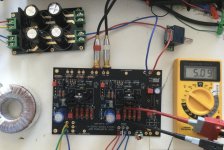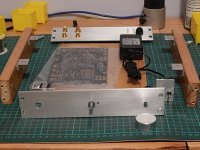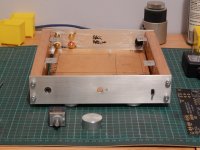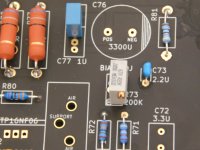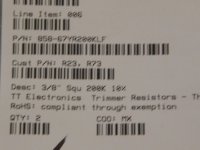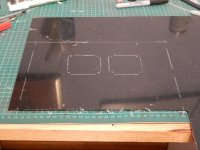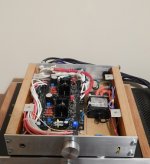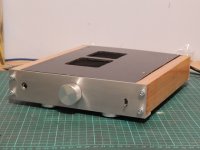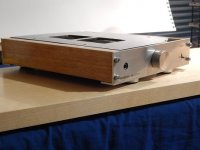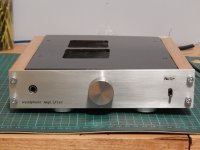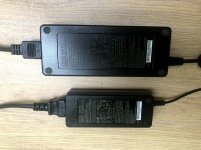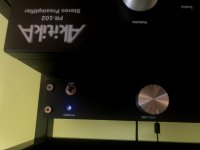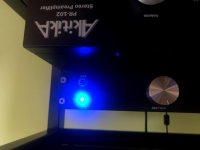My amp Noir
Hello,
I left aside my F6 while waiting for the arrival of the new JFETs, and started building the Black amp, and here it is.
Due to a problem with the blue Alps, which is totally asymmetrical, it will go to after-sales service, I replaced it temporarily with 2 10k.
the amp sounds beautifully on my Focal Elegia headphones, I rediscovered this headphones.
On the other hand, I did not use the SMPS power supply, but a more conventional power supply (toroidal 15v and 20,000uf Nichicon KG capacitor) to power it, I only have 22v in output, I don't think that the affected.
I am waiting for another power supply with 84 capacitors to finalize the assembly. and I reserve a subtle dressing for it, I will post the photos when it is finished.
Thank you so much Mark
Hello,
I left aside my F6 while waiting for the arrival of the new JFETs, and started building the Black amp, and here it is.
Due to a problem with the blue Alps, which is totally asymmetrical, it will go to after-sales service, I replaced it temporarily with 2 10k.
the amp sounds beautifully on my Focal Elegia headphones, I rediscovered this headphones.

On the other hand, I did not use the SMPS power supply, but a more conventional power supply (toroidal 15v and 20,000uf Nichicon KG capacitor) to power it, I only have 22v in output, I don't think that the affected.
I am waiting for another power supply with 84 capacitors to finalize the assembly. and I reserve a subtle dressing for it, I will post the photos when it is finished.
Thank you so much Mark

Attachments
Question about my build results
I'm new to electronics and high quality audio. The Noir was a lot of fun to build. The instructions were great and the layout of the board was very nice.
I learned a lot.
So, I'm not sure if I built the Noir correct or not. I was able to bias both channels and the power seems OK. I just received Beyerdynamic DT-990 250 ohm headphones (my first nice pair of headphones.) I'm using a Samsung Galaxy S10e direct input into the Noir, and plugging the phones into the 1/4" output jack.
The volume control works, but I have to turn the volume knob almost all the way up to get the same sound level that I get with just plugging the headphones directly into the Samsung. The Samsung is at about 3/4 volume.
The amp is very quiet, and the sound quality does seem to be enhanced. Don't take this the wrong way, but do you think that I have a problem? Or, is this to be expected, i.e. more about the audio quality than the volume?
Or, is this to be expected, i.e. more about the audio quality than the volume?
I'm new to electronics and high quality audio. The Noir was a lot of fun to build. The instructions were great and the layout of the board was very nice.
I learned a lot.
So, I'm not sure if I built the Noir correct or not. I was able to bias both channels and the power seems OK. I just received Beyerdynamic DT-990 250 ohm headphones (my first nice pair of headphones.) I'm using a Samsung Galaxy S10e direct input into the Noir, and plugging the phones into the 1/4" output jack.
The volume control works, but I have to turn the volume knob almost all the way up to get the same sound level that I get with just plugging the headphones directly into the Samsung. The Samsung is at about 3/4 volume.
The amp is very quiet, and the sound quality does seem to be enhanced. Don't take this the wrong way, but do you think that I have a problem?
Hi Dave.
Your Noir is just fine. The gain of Noir is just 6dB, that is 2 times in voltage, so don't expect too much of amplification or loundness. But let's see it the other way round: volume control is not about making the sound louder, it's vica versus - it's an attenuator, so actualy volume control is about making the sound level lower. Maximum volume could be regarded as a "normal" position of the volume control - no attenuation. You turn it to the left to make the sound level lower when it is too high for you Therefore, if your normal listening volume is close to the rightmost position of the volume control - it's marvelous, that means you are not "throwing away" much of a signal
Therefore, if your normal listening volume is close to the rightmost position of the volume control - it's marvelous, that means you are not "throwing away" much of a signal 
One more thing. When sourcing the signal from the phone, put the volume on the phone to maximum. Digital music quality is the best when you do not digitaly attenuate the output level. Then you control the volume on Noir. That should give you max quality.
Concerning the sound quality of Noir, I would say that no amplification device can improve the signal quality - any amplification can only add some distostion, not to make less distortion that it was in the source. Therefore, Noir is not making you phone output signal better per se, but it does make it a bit different. And if you like this difference - that's fantastic! Enjoy it!
Your Noir is just fine. The gain of Noir is just 6dB, that is 2 times in voltage, so don't expect too much of amplification or loundness. But let's see it the other way round: volume control is not about making the sound louder, it's vica versus - it's an attenuator, so actualy volume control is about making the sound level lower. Maximum volume could be regarded as a "normal" position of the volume control - no attenuation. You turn it to the left to make the sound level lower when it is too high for you
One more thing. When sourcing the signal from the phone, put the volume on the phone to maximum. Digital music quality is the best when you do not digitaly attenuate the output level. Then you control the volume on Noir. That should give you max quality.
Concerning the sound quality of Noir, I would say that no amplification device can improve the signal quality - any amplification can only add some distostion, not to make less distortion that it was in the source. Therefore, Noir is not making you phone output signal better per se, but it does make it a bit different. And if you like this difference - that's fantastic! Enjoy it!
In fact the max-possible-gain of Noir was designed to be low enough that, for most people and most headphones and most signal sources, the comfortable setting of the volume control would be between 50% and 100% of max-clockwise-rotation. That's where the two halves of the Alps Blue Velvet potentiometer exhibit the best tracking.
Thank you Dave! Noir is aimed at folks just like you, I'm thrilled your build was a success and you enjoy the music it makes. When you show your hand built Noir to friends, remember to say "there are only four transistors inside this box; two for the left channel and two for the right."
Custom Case
Here is my final build of the Noir with a custom case.
Aluminium angle from the hardware store on front and back, brushed with the green side of sponge scouring pad and then coated with
clear gloss floor varnish. I put the Meanwell power supply inside the case, no reason, I just like it that way and
have experienced no noise. In fact I could detect no background noise in normal use at all. Only had one issue with parts ordering
see photo.
being that I was sent 20k trimmer resistors instead of 200k. I noticed the value on top after soldering and thought this doesn't look right and got out the multimeter.
Sure enough they were 20k. I checked the packet and it was clearly marked containing
200k. Luckily I hadn't powered things up at this stage. The local electronics store had just opened again
after the pandemic rules here were relaxed and they had the right part in stock and with the adjustment screw on the top... rather then
the side... Phew!
Anyway it's all now done and sounds smooth and sweet right through the whole frequency range. Music pace was a surprise, showing me why
some songs sound more atmospheric when played slow and I don't recall ever noticing that before. The amber led is a nice touch
giving a nice old fashioned incandencent glow. I like my Sundara's best with it, but it doesn't seem to be too fussy, Neo 99's and even Mr Speakers
sound good too. As a preamp it's fine, but not as good I feel as the B1 in that role.
Here is my final build of the Noir with a custom case.
Aluminium angle from the hardware store on front and back, brushed with the green side of sponge scouring pad and then coated with
clear gloss floor varnish. I put the Meanwell power supply inside the case, no reason, I just like it that way and
have experienced no noise. In fact I could detect no background noise in normal use at all. Only had one issue with parts ordering
see photo.
being that I was sent 20k trimmer resistors instead of 200k. I noticed the value on top after soldering and thought this doesn't look right and got out the multimeter.
Sure enough they were 20k. I checked the packet and it was clearly marked containing
200k. Luckily I hadn't powered things up at this stage. The local electronics store had just opened again
after the pandemic rules here were relaxed and they had the right part in stock and with the adjustment screw on the top... rather then
the side... Phew!
Anyway it's all now done and sounds smooth and sweet right through the whole frequency range. Music pace was a surprise, showing me why
some songs sound more atmospheric when played slow and I don't recall ever noticing that before. The amber led is a nice touch
giving a nice old fashioned incandencent glow. I like my Sundara's best with it, but it doesn't seem to be too fussy, Neo 99's and even Mr Speakers
sound good too. As a preamp it's fine, but not as good I feel as the B1 in that role.
Attachments
Congratulations on a lovely build, LotsOfHiFiFun! Your custom enclosure is a thing of beauty; I'm particularly impressed by the very nice ventilation in the ceiling panel. The front panel slot for the power switch's toggle bat is a beautiful touch, too. Any chance we could see the final front panel with lettering (just barely visible in your final photo) at greater resolution?
Case build
Thanks for the reply Mark
Quick answer: first the front panel labeling was done with a Brother P-touch, which gives acceptable results for a one off project at normal viewing distances, but doesn't look so good up close. Still it's very cost effective and does the job.
If anyone has better options let me know. Here's a higher res photo below.
Like a lot of home case builders all I have is a drill press and a table saw, and cheap ones at that. But with a bit of experimenting,
clamps, an old Black and Decker work bench and a good dollop of imagination I feel I you can yield better results
than a lot of retail hi fi products with out spending a fortune.
The two square vents with rounded corners on the top, were partly born out of my experience with an AMB HPA I built some
years ago and had left on one morning after going to work. The Australian summer can get very hot and when I got home the perspex lid
was starting to droop. So I cut a great big square hole in it.
The round drill holes I originally made just wern't enough. Cutting neat square holes in perspex is painful. I'm still working out a better way
to do this as there a little out of square and I might give it another go. I did see a post here where someone used a nibbler on aluminium, Might look into that. The large holes do give a good view to the insides though which strengthens it's appeal.
Sort of like having valves on show.
Thanks for the reply Mark
Quick answer: first the front panel labeling was done with a Brother P-touch, which gives acceptable results for a one off project at normal viewing distances, but doesn't look so good up close. Still it's very cost effective and does the job.
If anyone has better options let me know. Here's a higher res photo below.
Like a lot of home case builders all I have is a drill press and a table saw, and cheap ones at that. But with a bit of experimenting,
clamps, an old Black and Decker work bench and a good dollop of imagination I feel I you can yield better results
than a lot of retail hi fi products with out spending a fortune.
The two square vents with rounded corners on the top, were partly born out of my experience with an AMB HPA I built some
years ago and had left on one morning after going to work. The Australian summer can get very hot and when I got home the perspex lid
was starting to droop. So I cut a great big square hole in it.
The round drill holes I originally made just wern't enough. Cutting neat square holes in perspex is painful. I'm still working out a better way
to do this as there a little out of square and I might give it another go. I did see a post here where someone used a nibbler on aluminium, Might look into that. The large holes do give a good view to the insides though which strengthens it's appeal.
Sort of like having valves on show.
Attachments
I have a question about the following Noir "behaviour".
I've got Akitika PR-102 preamp that has unity gain buffered DC coupled Tape outputs that always outputs a signal of your selected source. Therefore I thought it would be a good way to share my sources with Noir if I connect Noir inputs to Akitika Tape outputs. And it works fine, but I noticed one thing.
Noir power LED glows faintly when inputs are connected to Akitika Tape ouptputs even if Noir power is off, and that also does not depend if the signal is on or off on the Akitika Tape output. So, some current is going through the power LED of Noir.
Why does it happen and is that OK both for Noir and Akitika?
I've got Akitika PR-102 preamp that has unity gain buffered DC coupled Tape outputs that always outputs a signal of your selected source. Therefore I thought it would be a good way to share my sources with Noir if I connect Noir inputs to Akitika Tape outputs. And it works fine, but I noticed one thing.
Noir power LED glows faintly when inputs are connected to Akitika Tape ouptputs even if Noir power is off, and that also does not depend if the signal is on or off on the Akitika Tape output. So, some current is going through the power LED of Noir.
Why does it happen and is that OK both for Noir and Akitika?
I've never heard of this behavior (#273) before. I recommend you try the experiment again but this time unplug Noir's 24VDC wall wart. Unplug it from the wall AND unplug it from the Noir back panel jack. In this condition you can be confident that any LEDs which glow, are being powered by something else that isn't Noir.
Hi Mark. Yes, it does not glow with the PSU disconnected from Noir.
I made some experiments and I am sure this relates to the PSU I use for Noir and the fact that Akitika is well grounded and its input and output RCA sockets outer contacts are connected to ground as well.
I use the MeanWell SMPS power supply (24V, 1.67A) for Noir that has an EMI/RFI filtering and therefore energizes the common rail (the outer contact of the power plug) at half of mains voltage (~110V in Europe) making it a high impedance current source. Connected to the ground via the output of Akitika this makes it enough current for the LED to glow faintly, I suppose.
But there is another interesting thing. I also have MeanWell SMPS supplied by diyAudio store for ACA (24V, 5A) that does not energize the common rail to half of mains voltage. But if I plug it into Noir, the LED on the MeanWell PSU starts to pulsate in cycles of about 1-2 sec. and same happens to Noir LED when I put power on. This stops if I disconnect the RCA inputs from Noir. So, it seems that I would not be able to use this more powerful PSU with Noir and Akitika at all (though the smaller one works fine and I do not hear any ground loops or anything in the sound - it sounds perfectly well).
No problems with Noir if connected to the other source (like Allo Boss DAC which is not grounded). So its all about Akitika and the well grounded chassis/inputs/outputs of it.
What could you comment on this? I think there is no blame on Akitika nor Noir about it. But would you see any way to eliminate this "glowing effect"? Perhaps some additional diode or something in the schematics of Noir?
It would be interesting to learn something from all this.
I attach some pictures just for a reference: PSUs, Noir with glowing LED, Noir with well lit LED. BTW, the LED is quite bright (sensitive) by itself, I put 22K with it and it still a bit too bright in normal operation.
Edit: doh... photos are upside down... anyway...
I made some experiments and I am sure this relates to the PSU I use for Noir and the fact that Akitika is well grounded and its input and output RCA sockets outer contacts are connected to ground as well.
I use the MeanWell SMPS power supply (24V, 1.67A) for Noir that has an EMI/RFI filtering and therefore energizes the common rail (the outer contact of the power plug) at half of mains voltage (~110V in Europe) making it a high impedance current source. Connected to the ground via the output of Akitika this makes it enough current for the LED to glow faintly, I suppose.
But there is another interesting thing. I also have MeanWell SMPS supplied by diyAudio store for ACA (24V, 5A) that does not energize the common rail to half of mains voltage. But if I plug it into Noir, the LED on the MeanWell PSU starts to pulsate in cycles of about 1-2 sec. and same happens to Noir LED when I put power on. This stops if I disconnect the RCA inputs from Noir. So, it seems that I would not be able to use this more powerful PSU with Noir and Akitika at all (though the smaller one works fine and I do not hear any ground loops or anything in the sound - it sounds perfectly well).
No problems with Noir if connected to the other source (like Allo Boss DAC which is not grounded). So its all about Akitika and the well grounded chassis/inputs/outputs of it.
What could you comment on this? I think there is no blame on Akitika nor Noir about it. But would you see any way to eliminate this "glowing effect"? Perhaps some additional diode or something in the schematics of Noir?
It would be interesting to learn something from all this.
I attach some pictures just for a reference: PSUs, Noir with glowing LED, Noir with well lit LED. BTW, the LED is quite bright (sensitive) by itself, I put 22K with it and it still a bit too bright in normal operation.
Edit: doh... photos are upside down... anyway...
Attachments
Again and again, I have found it incredibly valuable to own a resistor kit containing a huge number of different resistances, each resistor value individually bagged and labeled (so I don't have to remember and apply the color code when I'm in a big hurry!). Now if I want to try a quick experiment or make a temporary modification, I know in advance that I've got the necessary resistor value. Without having to check. Why am I so sure? Because I've got them all!
Living in the USA, I bought a resistor kit like (this one from Amazon) and got Free Shipping. I happened to buy a 1/4watt kit; today that seller is offering a 1/2watt kit. That's not the only option; Amazon sells a large number of other resistor kits from other companies (examples), which increases the chances that one or more kit is in stock at an Amazon warehouse near you. Perhaps even with Amazon's lowest shipping fees to your city in your country. Double check the sales listing to make certain you're buying individually labeled resistor values and not just a big pile of resistors all jumbled together in a box. It's a bit of a warning flag if the Amazon sales photo shows a brightly printed color code map on the box; read the body of the Amazon page to determine whether the resistor values are bagged and individually labeled with text (a printed sticker).
With that background, I recommend to @avitkauskas that you perform a temporary experiment, to find out whether it makes your Noir pilot light LED go out completely, even in the dark.
Take a 270 ohm, 1/4 watt resistor {or any wattage >= 0.25 watts} from your set of resistors, and connect it directly in parallel with the legs of the LED. Adding this resistor will change the brightness of the LED, so you will want to re-adjust the 10K trimmer potentiometer "R2" at the bottom left corner of the PCB. Set it for the LED brightness you desire.
Now repeat the experiments in posts #273 and #275. Does the Noir pilot light LED go out and emit absolutely zero light, even in a dark room?
I'm sure you've made a large number of different measurements on your Noir using a DVM, under exactly the mystery conditions with power off and Other-Audio-Gear connected. Maybe you could post your measured data, along with your thoughts about what they may suggest.
_
Living in the USA, I bought a resistor kit like (this one from Amazon) and got Free Shipping. I happened to buy a 1/4watt kit; today that seller is offering a 1/2watt kit. That's not the only option; Amazon sells a large number of other resistor kits from other companies (examples), which increases the chances that one or more kit is in stock at an Amazon warehouse near you. Perhaps even with Amazon's lowest shipping fees to your city in your country. Double check the sales listing to make certain you're buying individually labeled resistor values and not just a big pile of resistors all jumbled together in a box. It's a bit of a warning flag if the Amazon sales photo shows a brightly printed color code map on the box; read the body of the Amazon page to determine whether the resistor values are bagged and individually labeled with text (a printed sticker).
With that background, I recommend to @avitkauskas that you perform a temporary experiment, to find out whether it makes your Noir pilot light LED go out completely, even in the dark.
Take a 270 ohm, 1/4 watt resistor {or any wattage >= 0.25 watts} from your set of resistors, and connect it directly in parallel with the legs of the LED. Adding this resistor will change the brightness of the LED, so you will want to re-adjust the 10K trimmer potentiometer "R2" at the bottom left corner of the PCB. Set it for the LED brightness you desire.
Now repeat the experiments in posts #273 and #275. Does the Noir pilot light LED go out and emit absolutely zero light, even in a dark room?
I'm sure you've made a large number of different measurements on your Noir using a DVM, under exactly the mystery conditions with power off and Other-Audio-Gear connected. Maybe you could post your measured data, along with your thoughts about what they may suggest.
_
Last edited:
Thank you for your response, Mark.
Yes, I do happen to have a resistor kit like this from Alliexpress for €0.86 (ok, shipping was twice as much, but combined with other items still arround €1.00
for €0.86 (ok, shipping was twice as much, but combined with other items still arround €1.00  ) Does the job for me so far. All what I measured indeed are in 1% tolerance.
) Does the job for me so far. All what I measured indeed are in 1% tolerance.
Anyway. Thanks for the idea to dim the LED. Simple. But for us, learning noobs, every little step is worth taking. I will try this in my next "soldering session" some weekend.
But the biggest surprise for me was the pulsating PSU from ACA (supplied from diyAudio with the ACA kit). It does not have this "residual" half the mains voltage on the plug, but it pulsates as being overloaded when the "other-audio-gear" is connected. I am not good enough yet, appearantly, to understand all the reasons behind this, but I hope one day I will find out why it happens.
Yes, I do happen to have a resistor kit like this from Alliexpress
Anyway. Thanks for the idea to dim the LED. Simple. But for us, learning noobs, every little step is worth taking. I will try this in my next "soldering session" some weekend.
But the biggest surprise for me was the pulsating PSU from ACA (supplied from diyAudio with the ACA kit). It does not have this "residual" half the mains voltage on the plug, but it pulsates as being overloaded when the "other-audio-gear" is connected. I am not good enough yet, appearantly, to understand all the reasons behind this, but I hope one day I will find out why it happens.
I am attempting to use the Noir as a pre amp to the ACA. Both ACA boards were able to bias properly. The Noir board was also able to bias properly. On their own, every thing seems to be working. At this point, I have not put an audio signal through any of the boards. The problem is, that when I connect the line outs to the ACA's. The Noir blows it's fuse. (.75) At his point, I am using the trannie that comes with the ACA's to power everything. I have tried reversing the polarity on the power inputs on the Noir. What do I need to do to make this combo work?
- Home
- Amplifiers
- Headphone Systems
- Noir, a two transistor headphone amp: class-A, single ended, 150mA bias
